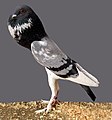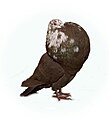Pigtails
As Pouters or pouter a group which is pigeons referred posed by other domestic pigeons by an upright posture and their large goitre , which they can fill with air, is different. The origin of this racial group is disputed.
description
Their relationship with the shape pigeons and ring bats is hardly noticeable from the outside, in addition, Spanish pith pigeons are related to the carrier pigeons . Pitters differ in body shape, posture, size and standing height, the shape of the crop on the chest and its shape. Typical goiter shapes are spherical, pear-shaped and drooping. The head of almost all breeds is smoothly feathered, only a few have a round or pointed cap. There are belatched and smooth-footed crooks and crooks with pearl eyes. The beaks are long. The colors and drawings of the pigeons are very diverse. The heart drawing, a white crescent moon on the goiter, is typical of some of these pigeons.
Kröpfer are lover pigeons and can become very tame and trusting. The inflation of the crop during courtship and the flying game, especially of drawn breeds, are a special incentive for crop pigeon breeders. In particular, the medium-legged, smooth-footed crop pigeon breeds "clap" in flight: they flap their wings over the head in such a way that a typical noise is created.
origin
Pitters are domestic pigeons whose origin is unknown or controversial. Their breeding in Europe has a tradition of more than 500 years. The Dutch animal painter Melchior de Hondecoeter is said to have painted a pouter known as an oplooper ( German dancer ) as early as 1665 . Aldrovandi described Dutch Kroppers in 1599 . Probably the first description of a piper can be found in an Arabic script from 1345 in Spain.
In 1590 the Indian Abdul Fazil characterized paraboves with the words "They have feathers on their feet and inhale air". Schütte suspects Indian potheads in them. There are also references to Bengal pouters, Syrian pitters, Chinese and Manchurian pitters.
Pitch Breeds
The European Standard Commission for Pigeons (ESKT) of the European Association for Poultry, Pigeon, Bird, Rabbit and Cavia Breeding (EE) has confirmed 51 breeds in the pouter group. (Status: November 2012) Some authors divide these again into the subgroups large pouters , dwarf peppers and hanging pouters or Spanish peppers , which can be differentiated again themselves. The following classification of races is therefore only an orientation.
Large caplets
Hartmann divides the large Kröpfer races into short-legged, long-legged and medium-high-legged. As short-legged large pouters , he leads the old German (D / 301) and Hungarian pith pigeons (H / 347). For the long-legged Großkröpfer be French (B / 307) and English Pouters (GB / 310) Hanakröpfer (CZ / 314) Pommersche (D / 303) Verkehrtflügel- (D / 304) Signoor- (B / 313) and Bavarian potheads (D / 315) called. Mittelhochbeinig are Elster (D / 305), Steiger (D / 318) and Stellerkröpfer (D / 319), Silesian (D / 323), Lille (B / 328) Voor Burger (NL / 327), Norwich (GB / 306), Slovak pouter (SK / 322), Moravian magpie pouter (CZ / 311), Moravian morak (CZ / 312), Moravian whitehead pouter (CZ / 321) and ice pigeon (CZ / 325).
Hartmann does not mention the Aachener Bandkröpfer (D / 326), Böhmischer Stellerkröpfer (CZ / 345), Danish Kröpfer (DK / 349), Alsatian Kröpfer (B / 308), Genter Kröpfer (B / 309), Hessischer Kröpfer ( D / 317), Holländischer Kröpfer (NL / 302), Horseman Kröpfer (GB / 332), Niederbayerischer Kröpfer (D / 345), Dutch Lockenkröpfer (NL / 352), Austrian Ganselkröpfer (A / 351), Saxon Kröpfer (D / 316), Schweizer Kröpfer (CH / 348), Starwitz grand piano controller Kröpfer (D / 320), Thuringian Kröpfer (D / 324) and Waldviertler Kröpfer (A / 350).
Schütte calls these breeds real pigeons.
Dwarf peppers
Dwarf peppers are 32 to 36 centimeters long and reach a wingspan of 60 to 65 centimeters. Among them are undisputedly the breeds Brno Kröpfer (CZ / 330) and English dwarf Kröpfer (GB / 329). Mostly the Amsterdamer Kröpfer (NL / 331) is mentioned and occasionally Liller Kröpfer, Voorburger Schildkröpfer and Prager Kröpfer are added to them.
Spanish and hanging potatoes
Schütte differentiates between the Spanish crop pigeons in three main groups: hanging crop breeds, breeds with normal blow molding and half crop with hardly any blow molding.
The hanging crop breeds are considered to be the oldest Iberian crop breeds. They are characterized by a horizontal posture and a sack-like, pear-shaped goiter. All representatives of this subgroup come from Spain or Portugal and were used for the sport of thieves, catchers or decoy pigeons , in which single pigeons lure strange pigeons into their loft in free flight.
Marchenero (E / 334) and Gaditano Kröpfer (E / 337) have a normal blow mechanism similar to the Central European races. The former can be traced back to the 15th century, the latter are of relatively recent origin. Regional variants of the Marchenero Kröpfers are also bred in South America and the USA .
The half crooks are relatively young. Because of their very high proportion of messenger and carrier pigeons , they only show their somewhat stronger blows while driving. For about sixty years a sport organized by clubs has been practiced with them. A hen is marked with a white goose feather on the tail and released together with a large number of cocks. They immediately start wooing the hen and try to drive her into her loft. The cock that manages this is a champion.
Morrillero Kröpfer (E / 341)
( German bull neck ), half crooker
Hanging cap
The hanging goiter is a typical disease for goiter pigeons. In the affected pigeons, the goiter hangs down limply, similar to that of Spanish goiters. It occurs when the feed remains too long in a lower crop enlargement, which causes fermentation of the leftover feed. Its occurrence can be favored by pathogens and stress. In old animals, relaxed skin muscles cannot be excluded as the cause.
Individual evidence
- ↑ a b Joachim Schütte: Handbook of the pigeon races. The pigeon breeds in the world . 1994, ISBN 978-3-9801504-4-6 ( Group IV: Pitchers ).
- ↑ a b Hans-Joachim Schille: Kropftauben . In: Manfred Hartmann (Ed.): Das Tauben Buch . Instructions for keeping and breeding pigeons. Deutscher Landwirtschaftsverlag, Berlin 1986, p. 32, 45 .
- ↑ a b Horst Marks: Pepper pigeons . In: The new Brehm library . A. Ziemsen Verlag, 1985, ISSN 0138-1423 .
- ↑ Entente Européenne d'Aviculture et de Cuniculture : EE list of pedigree pigeons (ELRT) ( Memento of the original from April 15, 2013 in the Internet Archive ) Info: The archive link has been inserted automatically and has not yet been checked. Please check the original and archive link according to the instructions and then remove this notice. , As of June 11, 2012 (PDF, approx. 150 kB)
- ↑ Joachim Schütte: Handbook of the pigeon races. The pigeon breeds in the world . 1994, ISBN 978-3-9801504-4-6 ( Zwergkröpfer ).
- ^ A b Kurt Vogel: Die Taube , Deutscher Landwirtschaftsverlag, Berlin 1984.
- ↑ a b Joachim Schütte: Handbook of the pigeon races. The pigeon breeds in the world . 1994, ISBN 978-3-9801504-4-6 ( Spanish crop pigeons ).
- ^ Klaus Dämmrich, Leo-Clemens Schulz: Pathology of domestic animals . Part 1. Organ changes. Georg Thieme Verlag, 1991, ISBN 978-3-334-00319-0 , p. 256 ( full text in Google Book Search).
















